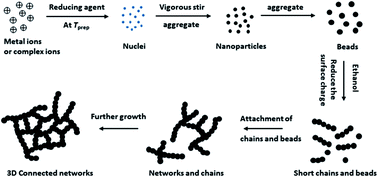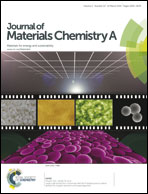Versatile synthesis of high surface area multi-metallic nanosponges allowing control over nanostructure and alloying for catalysis and SERS detection†
Abstract
We report a template- and surfactant-free synthesis of multi-metallic nanosponges with controllable composition, porosity, ligament and grain sizes, as well as control over alloying. The inexpensive approach is scalable to industrial production and produces not only sponges of various pure metals such as Ag, Au, Pd, Pt, Co, Ni, Cu, but also bi- and trimetallic alloys or non-alloys. The synthesis involves fast reduction of metal salts followed by a slow network assembly in ethanol–glycerol mixed solvents shaken in a temperature range of 25–90 °C. Freeze drying conserves the pores to ensure a high surface area. The involved growth mechanisms are discussed. Tri-metallic alloyed Ag34Au33Pd33 sponges with a specific surface area of 96 m2 g−1 exhibit the highest reported catalytic rate for the degradation of azo dyes and 4-nitrophenol reduction. They show higher catalytic activity and better long-term stability for formic acid electro-oxidation compared with Pd-based mono- and bimetallic nanostructures. The excellent catalytic performance is mainly attributed to the high porosity and large number of interfaces. Pressed into discs, the Ag sponges' sensitive SERS activity is highly reproducible over area.


 Please wait while we load your content...
Please wait while we load your content...